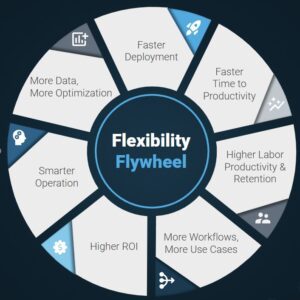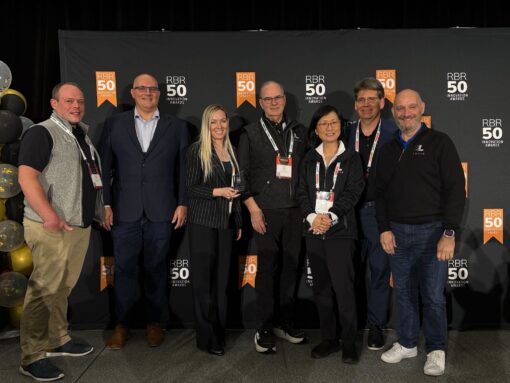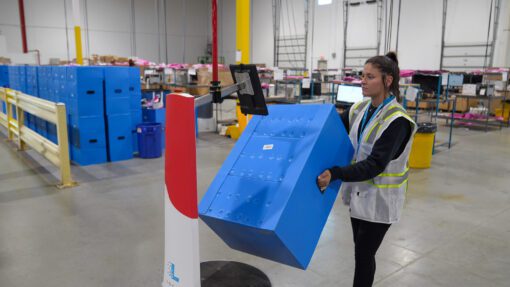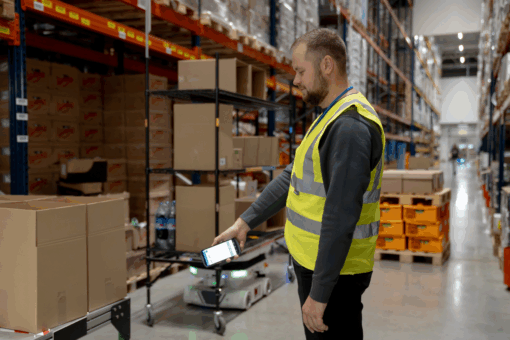WP: How to achieve 400 UPH with Locus Fast Pick
WP: How to achieve 400 UPH with Locus Fast Pick Download Now!
Maximizing Warehouse Productivity with Flexible Automation
Zaven "Zavo" Gabriel, Sr. Product Marketing Manager

Fulfillment today is full of uncertainty. When order volumes shift weekly, SKUs change daily, and labor availability fluctuates weekly, daily, and even hourly, fulfillment leaders need systems that can adapt. On a recent SupplyChainBrain webinar, I spoke with Bob Bowman about why flexibility is a survival strategy for warehouses.
The Real Meaning of Warehouse Flexibility
Fulfillment systems were once built for predictable environments with steady order volumes, reliable labor pools, and SKU assortments that changed on a seasonal, not daily, basis. Those assumptions no longer hold. In this new reality, the operations that succeed aren't necessarily the most efficient under ideal conditions. They're the ones that stay fast when nothing goes according to plan.
Warehouse flexibility means designing systems that adjust to unexpected demand surges, product mix shifts, labor shortages, and even layout changes without requiring a massive overhaul. Flexible automation allows warehouses to grow, pivot, and thrive, even as the ground constantly moves beneath them.
The Density Trap: A Cautionary Tale
One of the most common pitfalls in warehouse automation is what I call "the density trap."
Traditional fixed systems like AS/RS grids or goods-to-person (G2P) platforms are designed to maximize storage by cramming inventory into the smallest possible footprint. But maximum storage density isn’t the goal of a fulfillment operation. The goal is to get orders out accurately, quickly, predictably, and efficiently. Denser storage is only worthwhile to the extent that it supports that goal.
That’s the density trap: the idea that maximizing storage is the same as optimizing fulfillment. But when you overfit to one metric, all you’ve really done is box in your options.
At a recent trade show, I saw a case study of a warehouse with more than 170,000 totes packed into a dense grid, with more than 150 robots running inside it. These are impressive statistics, but the system also boasted just 34 pick stations. This meant that at any given moment, just 34 totes — 0.02% of the inventory — were immediately available for picking. Everything else was un-pickable and out of reach, either in transit or buried in the grid. In industries like healthcare, where urgency and precision are non-negotiable, that's a major liability.
Those bottlenecks are also hard-wired: they’re fundamental to the architecture of the system. No matter how many robots are running inside the grid or how efficiently they move totes, overall throughput is always capped by the number of pick stations. With fixed systems, expanding that capacity isn't a matter of reconfiguring workflows, it's a construction project.
Fulfillment isn't about how much you can store. It’s about speed, accuracy, and availability. Chasing storage density at the expense of flexibility is a costly mistake.
Flexible Systems Break the Bottlenecks
 When you design for flexibility, the entire architecture changes. There are no fixed walls between inventory and pick zones. Robots navigate freely, moving products around obstacles, through aisles, and directly to where they're needed. Every shelf is always accessible, and every pick zone can adapt to shifts in demand.
When you design for flexibility, the entire architecture changes. There are no fixed walls between inventory and pick zones. Robots navigate freely, moving products around obstacles, through aisles, and directly to where they're needed. Every shelf is always accessible, and every pick zone can adapt to shifts in demand.
Flexibility eliminates the fixed throughput ceilings that plague rigid systems. Capacity expands dynamically based on real-time needs, not static infrastructure, and the impact compounds over time. Flexible warehouse systems:
- Deploy faster with less disruption
- Train workers more quickly
- Adapt workflows to employee strengths
- Capture richer operational data
- Enable faster optimization and continuous improvement
This process is self-reinforcing. Each improvement feeds the next. Faster deployments mean faster productivity. Smarter workflows build richer data. The “flexibility flywheel” turns, and every turn makes the next one faster and easier.
Scaling Without Guessing
Flexibility also future-proofs warehouse operations. Instead of trying to predict what your fulfillment needs will look like in five or ten years, which is a risky proposition at best, flexible warehouse automation lets you scale organically.
Start with one workflow, one area, or one pain point. Then grow. As your business evolves, the system evolves too: whether adding new zones, new use cases, new robots, or new goals, the system scales with you, not ahead of you or behind you. Whether you're running 20 robots or 1,000, in a single facility or across 50 sites, a flexible platform like LocusONE™ orchestrates it all seamlessly.
This is true scalability: growing without friction, without overbuilding (or underbuilding), and without locking yourself into choices you can't undo.
Real-World Resilience
High throughput under pressure isn't theoretical. It's happening every day across Locus deployments worldwide. Like the million-square-foot warehouse with more than 700 robots that ship 200,000 units a day, or the facility that flexes its 300-robot fleet across three mezzanine levels. Around the world, thousands of coordinated robots are consistently handling millions of units daily, even — especially — during peak seasons and unexpected demand spikes.
In fulfillment, the only guarantee is change, so flexible systems are built to deliver performance when the real-world chaos hits.
The Future is Flexible
As fulfillment complexity continues to grow, the winners won't be those with the densest warehouses or the flashiest technology. They will be the ones that build for resilience and stay fast when nothing goes according to plan.
At Locus, we've picked more than five billion units across hundreds of customer sites because our customers chose flexibility, and because our platform evolves with them, not against them.
Fulfillment leaders facing pressure from every side need to reframe their strategy. Instead of trying to build the "perfect" system for today's snapshot of demand, they should build systems that can keep changing, keep adapting, and keep winning no matter what comes next.
Because in fulfillment, readiness will always beat rigidity.
Want to explore how flexible automation can future proof your operation? Let's talk.
BIO:
Zaven Gabriel is a seasoned product marketing professional with nearly a decade of experience in mobile robotics and supply chain. As a Product Marketing Manager at Locus Robotics, he shapes the company’s messaging, positioning, and go-to-market strategies, translating complex automation capabilities into clear, compelling value for customers.
A third-generation electrical engineer, Gabriel holds a degree in Electrical and Computer Engineering from Carnegie Mellon University. This deep technical foundation enables him to bridge the gap between engineering innovation and real-world logistics challenges.
Beyond robotics and automation, Gabriel is an avid cook and a lifelong Star Trek fan: always working, in his own way, to help nudge the world just a little closer to the future it dares to imagine.




